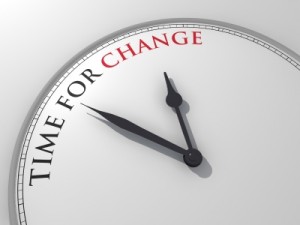 The fourth secret of change in my 5 part series of articles on the five secrets of change (if you missed any of the first three secrets you can find them here) is that change needs to be able to be progressive. It is possible to quit something cold turkey and we’ve probably all heard one amazing story of how someone did that. Most of the time there was a life-changing shift or change of circumstances that accompanies it. If you are that motivated and you are able to do it, then congratulations! Go for it! But how many of those stories have you heard?
The fourth secret of change in my 5 part series of articles on the five secrets of change (if you missed any of the first three secrets you can find them here) is that change needs to be able to be progressive. It is possible to quit something cold turkey and we’ve probably all heard one amazing story of how someone did that. Most of the time there was a life-changing shift or change of circumstances that accompanies it. If you are that motivated and you are able to do it, then congratulations! Go for it! But how many of those stories have you heard?
Most of us cannot make change by simply flipping a switch. We need to build new habits and progress over time. So any program that asks you to go cold turkey on something that you love or do regularly may be successful short-term, but the change won’t stick. Because as soon as you go back to your old ways of doing things, you’ll revert back to the old situation and gain the weight back, start spending again or fall back in front of the tv instead of working on your novel.
I teach indoor cycling and indoor rowing classes so I’m at a gym all year long. And every January I see people come full of enthusiasm, ready to start their exercise plans only to take on too much too soon and be too sore to come back for a week. They may come back one or two more times after that, but each time again, it’s too much and they need time to recover.
It feels hard and overwhelming, they are tired and sore and so they never make it a new habit. I see it over and over again. They need to start small and progress over time, allowing their bodies to adapt and building the new habits that will take over from the old. Just putting on their sneakers every day for a week may be their best start. That may seem ineffective, but if building the habit of getting sneakers on and getting dressed to exercise happens and becomes ingrained, it’s much easier to take the next step toward actually doing it and sticking with it.
Successful change programs give you the ability to progress and make evolutionary changes: in fact it’s the evolutionary changes that bring the revolutionary results.
Evolutionary change is more predictable change: it allows for the brain to prepare for what’s coming and anticipate it so that it doesn’t feel stress. It even allows you to prepare for weak moments and put a plan in place in advance for if they should occur. Anticipating temptation or even failure can cut off destructive actions as well as the guilt we can feel if we go off course.
In my course, Finally Make It Happen, we look at how to make change progressively. So if you want to start an exercise program, we look at what you can realistically fit into your life in terms of time and what works given your current state of wellness, and we create a starting point that is totally doable and feels effortless. That may be 10 reps or it may be putting on your sneakers. We start with what feels effortless and build that habit and then we work on progressing from there gradually over time.
If you want to drink less wine or coffee, we look at setting a goal of ½ a glass or ¼ glass less or whatever feels totally doable to you and then gradually, very gradually, we progress from there. That way you feel in control of your decisions and empowered and over time you can reach your goal without ever feeling deprived.
Hey if you can do it a little faster and progress a little more quickly, great: you don’t need to go that slow! But if something is hard for you or it feels like a big change, slow and steady progression will get you there and let you finally make it happen.
In my course, we also plan in advance for temptation or failure, putting strategies in place so that weak moments can be subverted and if we do go astray, we know we can come right back and carry on: all is not lost and we are not bad or weak. We can overcome our physiology with proven willpower weapons and stay on track.
That’s how my friend Mark lost 50 pounds and kept it off for over ten years: slow progressive changes, evolving over time so it never feels hard or like it’s too much or overwhelming. But you don’t need to wait to take my course to put this change secret into place.
Instead of trying to add an hour of exercise in or giving up ice cream, decide today to move your needle just a tiny bit in the direction you want to go. Even one less bite of ice cream, one extra glass of water or 5-10 minutes walking at lunch is a step in the direction of reaching your goals and fulfilling your dream and once you’re moving, you can continue to progress over time at the right pace for you until you Finally Make It Happen.
To your wellness and health: your true wealth!
Inger
Author: Inger Pols is the Editor of the New England Health Advisory and Author/Creator, Finally Make It Happen, the proven process to get what you want. Get a free special report on The Truth About Sugar: It’s Not All Equal. Learn more about Inger and receive her free bestselling ebook What Your Doctor Isn’t Telling You at www.ingerpols.com/freegifts.
Article Photo: courtesy of digitalart | FreeDigitalPhotos.net


 The third secret of lasting change in my 5 part series on the five serest of change (if you missed the previous secrets, you can
The third secret of lasting change in my 5 part series on the five serest of change (if you missed the previous secrets, you can  In this second part of a 5 part series on the five secrets of change, (if you missed the first secret, you can
In this second part of a 5 part series on the five secrets of change, (if you missed the first secret, you can 
 Follow me on Twitter
Follow me on Twitter 